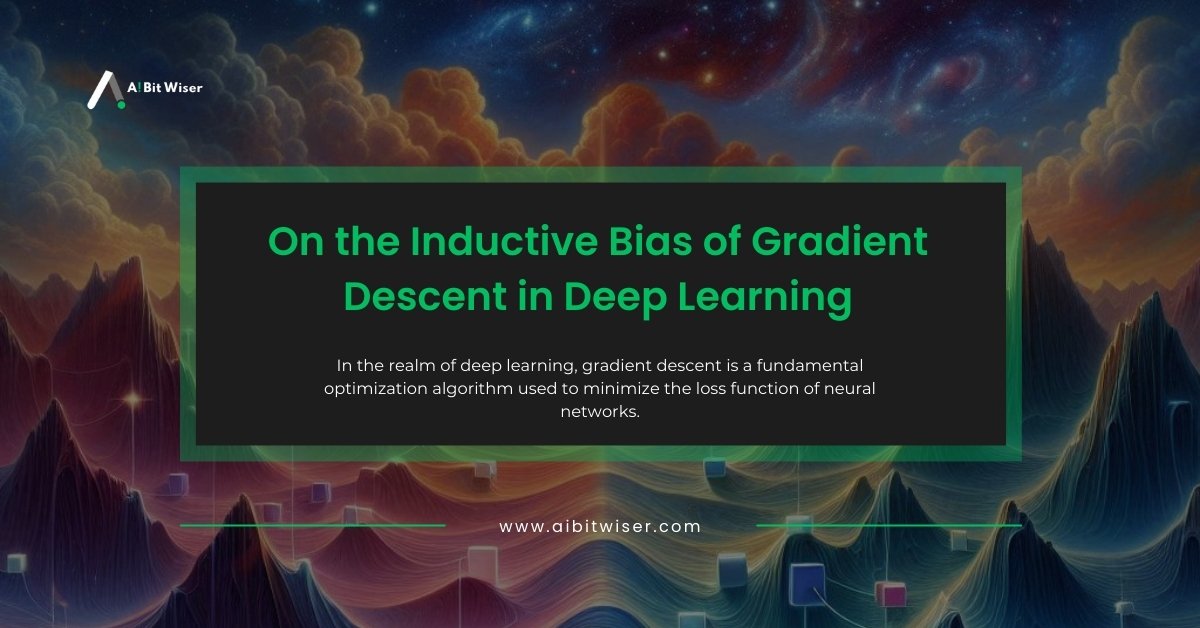On the Inductive Bias of Gradient Descent in Deep Learning

Introduction
On the Inductive Bias of Gradient Descent in Deep Learning: In the realm of deep learning, gradient descent is a fundamental optimization algorithm used to minimize the loss function of neural networks. The concept of inductive bias refers to the set of assumptions that a learning algorithm makes to generalize beyond the training data.
Understanding the inductive bias of gradient descent is crucial as it influences the generalization performance of deep learning models. This article delves into the inductive bias of gradient descent in deep learning, exploring how it shapes the learning process and impacts model performance.
The Role of Gradient Descent in Deep Learning
Gradient descent is an iterative optimization algorithm used to find the minimum of a function. In the context of deep learning, it is employed to minimize the loss function, which measures the difference between the predicted and actual outputs. By iteratively adjusting the model parameters in the direction of the negative gradient of the loss function, gradient descent aims to find the optimal set of parameters that minimize the loss.
Inductive Bias in Machine Learning
Inductive bias refers to the set of assumptions that a learning algorithm uses to make predictions on new data. These assumptions guide the learning process and influence the generalization ability of the model. In machine learning, inductive bias is essential because it helps the model generalize from the training data to unseen data. Without inductive bias, a model might overfit the training data and fail to perform well on new data.
Inductive Bias of Gradient Descent
The inductive bias of gradient descent in deep learning is shaped by several factors, including the choice of network architecture, the initialization of parameters, and the optimization algorithm itself. One of the key aspects of the inductive bias of gradient descent is its tendency to find solutions that are simple and generalizable. This implicit regularization effect is a result of the optimization process and the structure of the neural network.
Implicit Regularization
Implicit regularization refers to the phenomenon where the optimization process itself imposes a form of regularization on the model, even in the absence of explicit regularization techniques such as weight decay or dropout. In the case of gradient descent, this implicit regularization is believed to arise from the dynamics of the optimization process. For example, gradient descent tends to find solutions that have low complexity, such as sparse or low-rank solutions, which are often more generalizable.
The Role of Network Architecture
The architecture of the neural network plays a significant role in determining the inductive bias of gradient descent. Different architectures impose different constraints on the optimization process, leading to different inductive biases. For instance, convolutional neural networks (CNNs) are biased towards learning spatial hierarchies, while recurrent neural networks (RNNs) are biased towards learning temporal dependencies. The choice of architecture can thus influence the types of solutions that gradient descent converges to and their generalization properties.
Parameter Initialization
The initialization of parameters also affects the inductive bias of gradient descent. Different initialization schemes can lead to different optimization trajectories and, consequently, different solutions. For example, initializing parameters with small random values can lead to solutions that are more generalizable, while initializing with large values might result in overfitting. The choice of initialization scheme can thus impact the inductive bias and the generalization performance of the model.
Optimization Algorithm Variants
There are several variants of gradient descent, such as stochastic gradient descent (SGD), mini-batch gradient descent, and momentum-based methods. Each variant introduces different inductive biases due to the differences in how they update the model parameters. For example, SGD introduces noise into the optimization process, which can help escape local minima and find more generalizable solutions. Momentum-based methods, on the other hand, introduce a form of inertia that can help smooth the optimization trajectory and improve convergence.
Empirical Evidence and Theoretical Insights
Empirical studies have shown that the inductive bias of gradient descent plays a crucial role in the success of deep learning models. For instance, research has demonstrated that gradient descent can efficiently find low-rank solutions in matrix completion problems and sparse solutions in separable classification tasks. These findings suggest that the inductive bias of gradient descent helps in finding solutions that are both simple and generalizable.
Theoretical insights into the inductive bias of gradient descent have also been developed. For example, it has been shown that the parameter-to-hypothesis mapping in deep neural networks is biased towards simpler functions, as measured by Kolmogorov complexity. This theoretical understanding helps explain why gradient descent often finds solutions that generalize well to new data.
Conclusion: On the Inductive Bias of Gradient Descent in Deep Learning
The inductive bias of gradient descent in deep learning is a critical factor that influences the generalization performance of neural networks. By understanding the implicit regularization effects, the role of network architecture, parameter initialization, and optimization algorithm variants, researchers and practitioners can better design and train deep learning models. The interplay between these factors shapes the inductive bias of gradient descent, ultimately determining the success of deep learning applications.
FAQs: On the Inductive Bias of Gradient Descent in Deep Learning
What is inductive bias in deep learning?
When a model generalizes from training data to unknown data, it is said to be exhibiting inductive bias in deep learning. These biases direct the process of learning and aid in the model’s prediction-making. Convolutional neural networks (CNNs), for instance, are useful for image identification tasks because of their inductive leaning towards spatial hierarchy.
What is the problem with gradient descent in deep learning?
Deep learning’s core optimization process, gradient descent, can run into problems like disappearing and expanding gradients. Gradients that are too tiny might cause the vanishing gradient problem, which slows down or stops training. When gradients get too big, it can lead to unstable updates and even the model diverging. This is known as the “exploding gradient problem.”
What is inductive bias in decision tree classifier?
Decision tree classifiers with inductive bias tend to favor simpler, easier-to-understand models. Decision trees operate on the assumption that a sequence of binary decisions may be used to divide the data into discrete, non-overlapping parts. This tendency toward simplicity aids in bettering generalization and preventing overfitting.
What is implicit bias in machine learning?
Unintentional and unconscious biases that may affect how machine learning models perform are referred to as implicit bias in the field of machine learning. Unfair or discriminatory predictions may result from these biases, which may originate from the algorithms themselves or from the data used to train the models.
What is implicit bias and examples?
Implicit bias, often referred to as unconscious prejudice, is the term used to describe the attitudes or preconceptions that subtly influence our perceptions, judgments, and behaviors. For instance, an individual may unintentionally link crime to a specific race, or a hiring manager may unintentionally prefer applicants from their alma college.










